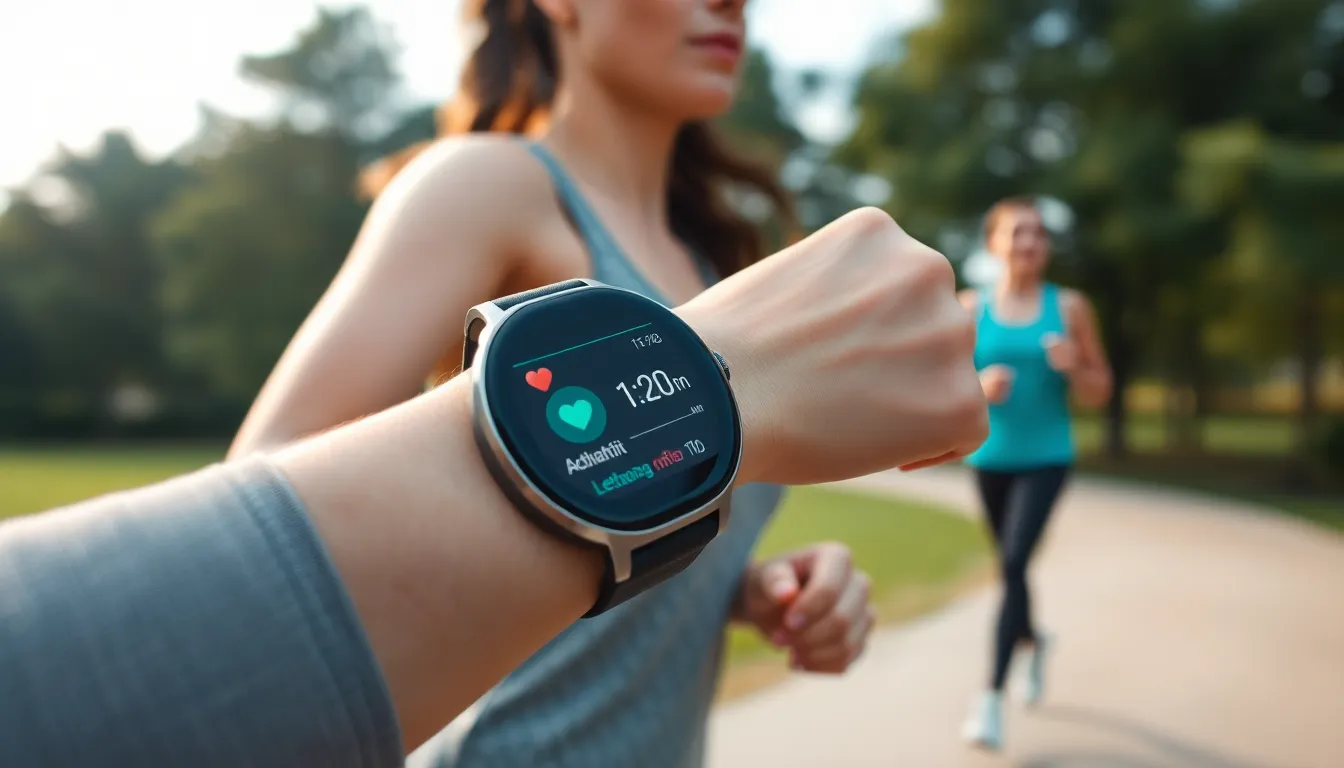Table of Contents
ToggleIn a world where even your toaster can connect to the internet, smartwatches have become the ultimate sidekick for tech-savvy individuals. These sleek gadgets not only tell time but also keep you updated on everything from your heart rate to your calendar. Imagine having a tiny assistant strapped to your wrist, reminding you of meetings and counting your steps while you pretend to be active.
Overview of Smartwatches IoT
Smartwatches integrate seamlessly into the Internet of Things (IoT), creating a network of interconnected devices. They allow users to interact with various smart home devices, such as lights, thermostats, and security systems. Enhanced connectivity enables users to receive real-time updates and notifications without needing their smartphones.
Health tracking features represent a significant aspect of smartwatches. These devices monitor heart rates, sleep patterns, and physical activities, providing users with valuable insights into their well-being. Many models offer advanced features, including ECG monitoring and SpO2 tracking, enhancing their utility in personal health management.
Data exchange between smartwatches and other devices occurs through established connectivity protocols such as Bluetooth and Wi-Fi. Users benefit when these protocols facilitate communication with fitness apps and medical services, promoting a more holistic approach to health and fitness monitoring.
Incorporating voice assistants further enriches the user experience. Users can utilize voice commands to control their devices, making interactions hands-free and convenient. This feature not only illustrates the smartwatch’s multifaceted functionality but also enhances the integration of everyday tasks.
Security features also stand out in today’s smartwatches. Many devices include biometric authentication methods, such as fingerprint sensors or facial recognition, protecting sensitive user data. These security measures ensure that personal information remains secure in an interconnected environment.
Manufacturers consistently innovate, introducing new applications and features that expand the smartwatch’s capabilities. Frequent software updates deliver enhanced functionalities and improved performance, ensuring devices remain relevant in the rapidly evolving tech landscape. With such advancements, smartwatches solidify their position as essential components of the IoT ecosystem.
Key Features of Smartwatches IoT
Smartwatches offer numerous features that enhance their functionality in the IoT landscape. These devices connect seamlessly with other gadgets, providing users with a holistic experience.
Connectivity and Communication
Connectivity remains a fundamental aspect of smartwatches. Many devices support both Bluetooth and Wi-Fi, facilitating communication with smartphones and smart home systems. Users can receive notifications, respond to messages, or control home devices directly from their wrists. The integration with platforms like Google Assistant and Siri ensures hands-free interaction, letting users access information effortlessly. Smartwatches bridge the gap between various devices, creating a cohesive ecosystem that enhances user convenience and engagement.
Sensors and Health Monitoring
Health monitoring systems play a crucial role in smartwatch functionality. Advanced sensors track metrics such as heart rates, sleep patterns, and physical activities. Users benefit from capabilities like ECG monitoring and SpO2 tracking, providing insights into their health status. Many smartwatches also analyze fitness data and generate reports, encouraging users to reach their health goals. Continuous advancements in sensor technology lead to more accurate and reliable health metrics, further establishing smartwatches as essential tools for health management in the IoT domain.
Popular Smartwatches in the IoT Market
Smartwatches play a significant role in the IoT market, offering features that enhance connectivity and usability. Their expanding capabilities attract users looking for effective health monitoring and smart home integration.
Apple Watch Series
The Apple Watch Series stands out with its robust health tracking features. Heart rate monitoring, ECG capabilities, and SpO2 tracking allow users to stay on top of their health. Seamless integration with iOS devices enhances functionality, making it easy to manage notifications and control smart home devices via Siri. The always-on display offers quick access to information, and its apps cater to fitness enthusiasts and casual users alike. Regular software updates introduce new features, ensuring the device remains relevant in the fast-paced tech landscape.
Samsung Galaxy Watch
Samsung Galaxy Watch boasts a sleek design and extensive health monitoring functionalities. Advanced features include body composition analysis, sleep tracking, and stress management tools. Users benefit from its compatibility with both Android and iOS devices, promoting wider accessibility. The integration of Bixby enhances hands-free functionality while enabling smart home control. Notifications and messaging capabilities provide convenience without reaching for a smartphone. Regular updates ensure it stays competitive in the evolving smartwatch market.
Fitbit Versus Garmin
Fitbit and Garmin cater to different user preferences within the smartwatch market. Fitbit focuses on fitness and wellness, with a user-friendly interface and strong community engagement. Exercise tracking and sleep insights help users achieve their fitness goals. Garmin emphasizes performance and durability, appealing to serious athletes with advanced metrics like VO2 max and recovery tracking. Both brands offer compatibility with various IoT ecosystems, ensuring users can enjoy tailored experiences based on their chosen devices. Each brand innovates consistently, driving advancements in health tracking and smart connectivity.
Future Trends in Smartwatches IoT
Innovations in smartwatches and IoT are rapidly shaping the future of wearable technology. Increased integration with Artificial Intelligence (AI) showcases how these devices can analyze user behavior and tailor health insights more effectively. Advanced algorithms are emerging, allowing for predictive health monitoring, which could revolutionize personal healthcare management.
Developments in battery life are promising improvements. Users can expect chargers capable of lasting longer, ensuring smartwatches remain functional throughout the day. Enhanced energy-efficient designs will support more advanced features without sacrificing performance.
Improved connectivity protocols are expanding smartwatches’ capabilities. The introduction of 5G technology allows for faster data transmission between devices, leading to quicker updates and seamless interactions with smart home systems. This advancement enhances the overall user experience, making interactions more fluid and immediate.
Customization and personalization also play a significant role in future trends. Wearable technology will incorporate modular designs, permitting users to upgrade specific components based on individual preferences. Tailoring devices to personal tastes could foster greater consumer engagement within the market.
Security measures are evolving alongside functionality. Biometric sensors will become increasingly sophisticated, reinforcing user privacy and data protection. Improved encryption techniques will further secure sensitive information, building trust among consumers.
Integration with health services is another anticipated trend. Smartwatches will likely connect directly with healthcare providers, facilitating real-time health monitoring and emergency alerts. These advancements might lead to proactive health measures, allowing for earlier detection of potential health issues.
Sustainable materials are gaining attention as manufacturers prioritize environmental responsibility. The use of recyclable materials will appeal to eco-conscious consumers, influencing purchasing decisions in the smartwatch market.
Overall, these trends highlight a holistic advancement in smartwatches, positioning them as vital components of the IoT ecosystem in the future.
Challenges and Concerns
Security stands as a primary challenge for smartwatches within the IoT framework. Many devices transmit sensitive health information, making them targets for cyberattacks. Personal data security concerns necessitate robust encryption measures to safeguard user information.
Privacy issues also arise as smartwatches continuously collect data and monitor users’ activities. Potential misuse of this information can lead to unauthorized access, creating distrust among users. Manufacturers must prioritize transparent data policies to mitigate privacy risks.
Battery life poses another significant concern. Advanced features and constant connectivity consume power rapidly, often requiring daily recharging. Innovations in energy-efficient designs could extend battery life, enhancing user experience and reducing inconvenience.
Interoperability challenges complicate seamless interaction among various IoT devices. Not all smartwatches support the same protocols, leading to compatibility issues across different ecosystems. Ensuring devices can communicate effectively plays a crucial role in improving overall functionality.
Health monitoring accuracy remains a vital focus area. While many smartwatches offer impressive capabilities, discrepancies in readings can impact user trust. Continuous advancements in sensor technology can enhance reliability for vital metric tracking.
User interface complexity can frustrate some individuals. A steep learning curve may deter less tech-savvy users from fully utilizing smartwatch features. Simplifying navigation while maintaining functionality is essential for broader adoption.
Sustainability concerns arise as consumers increasingly prioritize eco-friendly practices. Smartwatches often use materials with environmental impacts, necessitating a shift towards sustainable alternatives. Manufacturers that embrace eco-conscious practices can appeal to environmentally aware users.
Conclusion
Smartwatches are transforming the way individuals interact with technology and manage their health. As they become increasingly integrated into the IoT ecosystem their multifunctionality enhances convenience and connectivity. With continuous innovations in health tracking and user experience these devices are solidifying their place as essential gadgets in everyday life.
As manufacturers focus on improving security and sustainability concerns the future of smartwatches looks promising. Enhanced features powered by AI and 5G technology will likely redefine user engagement and health management. Embracing these advancements will empower users to make informed decisions about their health and lifestyle while enjoying the practicality and style that smartwatches offer.








